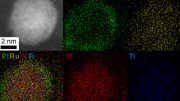When it was announced that LIGO detected gravitational waves this past February, astrophysicists wondered about something else: Had the experiment found the “dark matter” that makes up most of the mass of the universe?
This simulation of the binary black-hole coalescence GW151226 shows two black holes of 14 and 8 solar masses orbiting each other.
The eight scientists from the Johns Hopkins Henry A. Rowland Department of Physics and Astronomy had already started making calculations when the discovery by the Laser Interferometer Gravitational-Wave Observatory (LIGO) was announced in February. Their results, published recently in Physical Review Letters, unfold as a hypothesis suggesting a solution for an abiding mystery in astrophysics.
“We consider the possibility that the black hole binary detected by LIGO may be a signature of dark matter,” wrote the scientists in their summary, referring to the black hole pair as a “binary.” What follows are five pages of annotated mathematical equations showing how the researchers considered the mass of the two objects LIGO detected as a point of departure, suggesting that these objects could be part of the mysterious substance known to make up about 85 percent of the mass of the universe.
A matter of scientific speculation since the 1930s, dark matter has recently been studied with greater precision; more evidence has emerged since the 1970s, albeit always indirectly. While dark matter itself cannot yet be detected, its gravitational effects can be. For example, dark matter is believed to explain inconsistencies in the rotation of visible matter in galaxies.
The Johns Hopkins team, led by postdoctoral fellow Simeon Bird, was struck by the mass of the black holes detected by LIGO, an observatory that consists of two expansive L-shaped detection systems anchored to the ground. One is in Louisiana and the other in Washington State.
Black hole masses are measured in terms of multiples of our sun. The colliding objects that generated a gravity wave detected by LIGO – a joint project of the California Institute of Technology and the Massachusetts Institute of Technology — were 36 and 29 solar masses. Those are too large to fit predictions of the size of most stellar black holes, the ultra-dense structures that form when stars collapse. But they are also too small to fit the predictions of the size of supermassive black holes at the center of galaxies.
The two LIGO-detected objects do, however, fit within the expected range of mass of “primordial” black holes.
Primordial black holes are believed to have formed not from stars but from the collapse of large expanses of gas during the birth of the universe. While their existence has not been established with certainty, primordial black holes have in the past been suggested as a possible solution to the dark matter mystery. Because there’s so little evidence of them, though, the primordial black hole-dark matter hypothesis has not gained a large following among scientists.
The LIGO findings, however, raise the prospect anew, especially as the objects detected in that experiment conform to the mass predicted for dark matter. Predictions made by scientists in the past held that conditions at the birth of the universe would produce lots of these primordial black holes distributed roughly evenly in the universe, clustering in halos around galaxies. All this would make them good candidates for dark matter.
The Johns Hopkins team calculated how often these primordial black holes would form binary pairs, and eventually collide. Taking into account the size and elongated shape believed to characterize primordial black hole binary orbits, the team came up with a collision rate that conforms to the LIGO findings.
“We are not proposing this is the dark matter,” said one of the authors, Marc Kamionkowski, the William R. Kenan, Jr. Professor in the Department of Physics and Astronomy. “We’re not going to bet the house. It’s a plausibility argument.”
More observations from LIGO and other evidence will be needed to support this hypothesis, including further detections like the one announced in February. That could suggest greater abundance of objects of that signature mass.
“If you have a lot of 30-mass events, that begs an explanation,” said co-author Ely D. Kovetz, a postdoctoral fellow in physics and astronomy. “That the discovery of gravitational waves could be connected to dark matter” is creating lots of excitement among astrophysicists, he said.
“It’s got a lot of potential,” Kamionkowski said.
Reference: “Did LIGO Detect Dark Matter?” by Simeon Bird, Ilias Cholis, Julian B. Muñoz, Yacine Ali-Haïmoud, Marc Kamionkowski, Ely D. Kovetz, Alvise Raccanelli and Adam G. Riess, 19 May 2016, Physical Review Letters.
DOI: 10.1103/PhysRevLett.116.201301









As a physicist, this is the best explanation I’ve see to date for “dark matter”. Black holes of medium size would fit the bill perfectly. I hope for proof (either way) soon.
If it were true, how would it impact the possibility/practicality of interstellar and intergalactic travel?
..just a quick question if i am to understand the lineage of dark matter. the initial & therefore the ‘final’ spin is determined/set at the event horizon..
Dark energy and Dark matter are mirages
http://vixra.org/pdf/1111.0051v6.pdf pp.161–167
**Asked on another article too**
(https://scitechdaily.com/ligo-detects-gravitational-waves-again/)
Can gravitational waves within our own universe be caused by massive gravitational objects from neighboring universes? Or are gravitational waves and influences on Dark Matter only possible in our own Universe? Could gravitational waves be an indicator of two universes “rubbing” against one another too?
Four plane ejections of Quantum mechanical system forming a neutral plane Dark domain forming a dark matter hollow shrouds in between is only a relative emission:
A combination of neutron plane feeding three domains as if forming a star type mass flow observed in between activated through the neutral plane .When mass iceberg being transferred the light rays amplified to produce more brightness while emitting more infra ryas.Stripping of mass energy from the galaxy forming dark matter holos dark matter clumps illuminated the galaxy Our current understanding is that all galaxies exist inside clumps of dark matter. Without the constraining effect of dark matter’s gravity, galaxies like the Milky Way would fling themselves apart as they rotate. In order to prevent this, 85 percent of the Universe’s mass must exist as dark matter, and yet its true nature remains a mystery. Lead author Richard Massey at Durham University, explains: “We used to think that dark matter just sits around, minding its own business, except for its gravitational pull. But if dark matter were being slowed down during this collision, it could be the first evidence for rich physics in the dark sector — the hidden Universe all around u Taking into account the size and elongated shape believed to characterize primordial black hole binary orbits.
But the binding energy sharing the three clusters controlled by three phasor clusters may eject the fifth plane Halls domain as energy capacitor dynamics.